Pot-Baked Coney in Wine and Cream
Also known as “Gardener’s Revenge:” a tasty aftermath to rural pest control
- Background
- Recipe
The implacably hostile dynamic prevailing between rural gardeners and the creatures that compete with them for the produce of the household vegetable patch is one that occupies a small but nonetheless noticeable percentage of our Earth’s English-language literature. Peter Rabbit would possibly be the best-known example for a lot of us in this regard. The gardener (often only glimpsed in the background) is routinely seen as the fall guy for the gleeful wildlife who’re intent on making off with the juicy produce before the gardener can reap the rewards of all those weeks and months of hard work.
Needless to say, in reality (and other areas of unreality) the wildlife is rarely so unilaterally lucky as in popular fiction. In the Four Realms, where the quality of people’s diets can depend heavily on their vegetables being safely harvested and stored, the rabbit is seen as an endlessly annoying pest, and one that in turn is seen as—pardon the pun—entirely fair game for enthusiastic predation.
As a result, food lore and practice in the Middle Kingdoms contains a wealth of recipes intended for the flavorsome disposal of those cute furry little creatures that unjustly see themselves as entitled to whatever you’ve got growing in the vegetable patch. Many of these dishes go by names like “Gardener’s Revenge.” In quite a few of them, the rabbit on which the dish is based is cooked and/or served with some of the vegetables that would have been the target of their brigandage.
This recipe falls into that category. In Tales of the Five #2: The Landlady, it’s one of many dishes served to Segnbora on her first visit as Head of House to the tai-Sesmenni family—the Holders of a linen-growing property in the foothills of midlands Darthen. There the rabbits descend yearly on the linen fields to feast on the tender new shoots of the plants on which the family’s livelihood depends. And all during the early spring growing season, the tai-Sesmennis feast in return on any rabbits unwary enough to run afoul of their many traps or the shot from their slings.
The recipe described here seems to have been devised by the family’s master-cook Tik (described as “one of those people whose cradle the Goddess visits to put a cooking-spoon into the baby’s hand as soon as possible”). In it, the rabbit is fried in butter, then simmered slowly in white wine and spices until the meat is ready to fall off the bone. Then it’s removed from the stock while that’s reduced over higher heat and finished with thick fresh cream. After that, everything’s heated through one last time in the oven while the vegetables are prepared.
The detailed recipe is in the right-hand tab above.
The ingredients:
- 1 large rabbit jointed into 6 pieces (or if preferred, 6 large chicken thighs)
- 2 large shallots, finely diced (optional)
- 2 tablespoons plain flour
- 50g butter
- 1 tablespoon olive oil
- 200 ml dry white wine
- 1 tablespoon coarse-grind mustard (such as Dijon)
- 500 ml chicken stock (or veal stock if available)
- 100ml double cream
- 2 sprigs fresh thyme (or 0.5 teaspoon dried flaked thyme)
- 1 bay leaf
The method:
Preheat the oven to 180 C / 375 F
If your rabbit hasn’t yet been jointed: this is what it’ll look like.
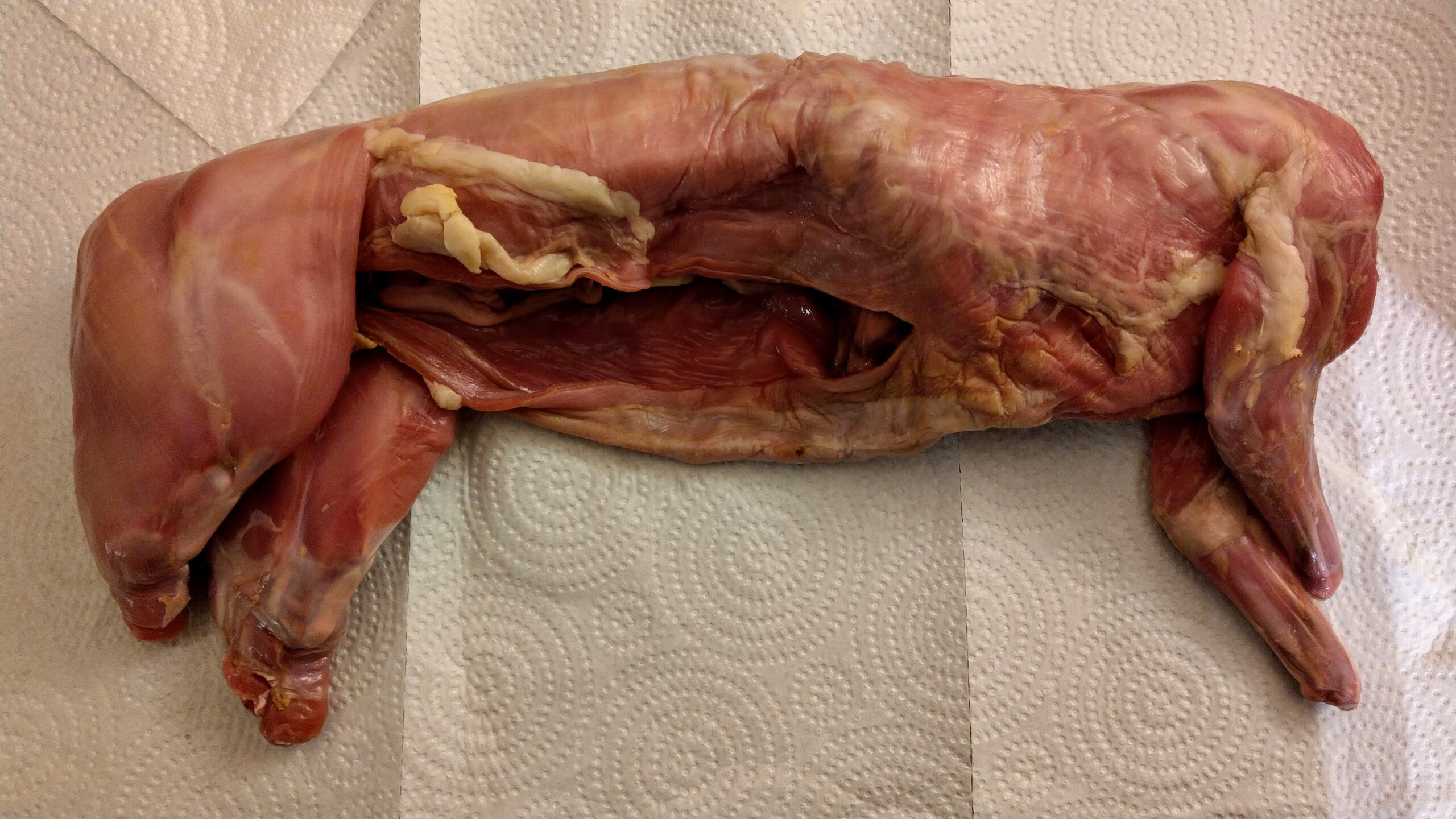
Take a moment and view this handy video on how to joint it.
Once it’s jointed: season the portions with salt and black pepper (and if you like, with a little ground nutmeg or allspice. I had both, and so used both). …This is what the jointed rabbit looks like:
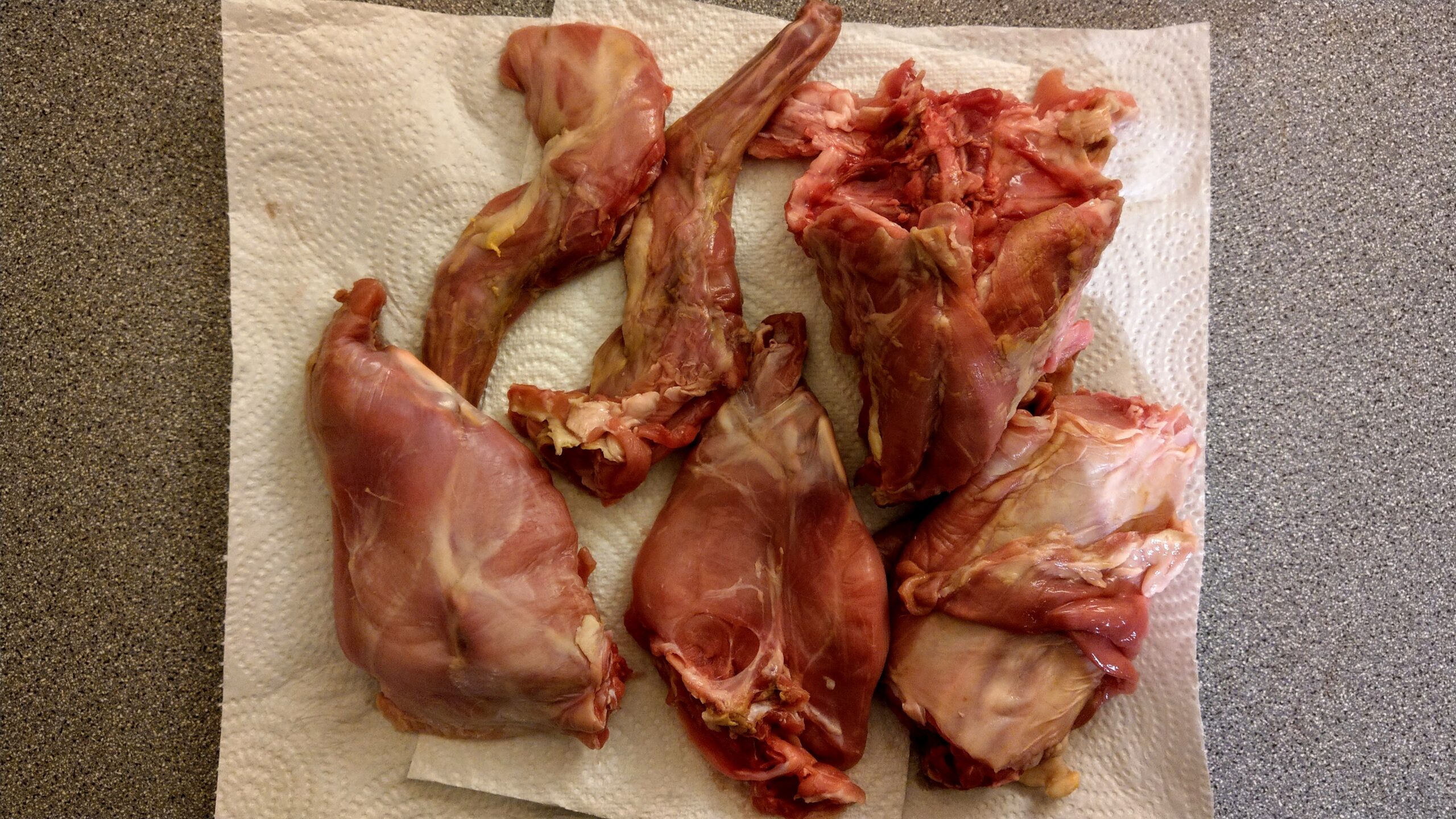
Once you’ve seasoned the rabbit pieces, melt the butter in a large cast iron or enamelled pot. Add the rabbit pieces to it and sauté them gently on all sides until they’re well browned.
If the size of your pot means you need to do this a couple of times to avoid overcrowding, that’s fine.
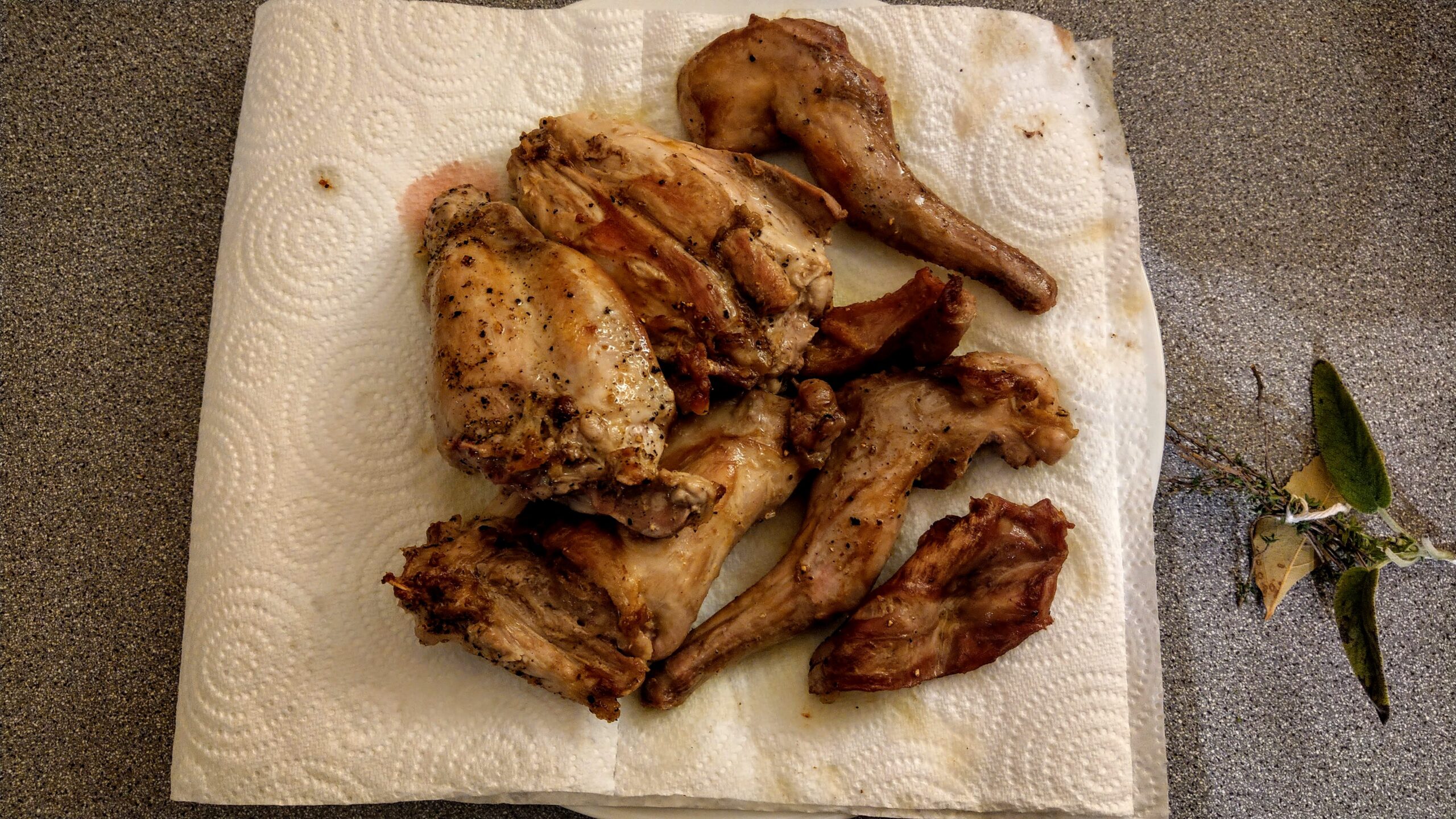
If you’re using shallots in this dish, remove the rabbit to a plate and saute the chopped shallots in the butter. When they’ve gone translucent, add the flour to them and stir well, continuing to saute until they’re going a soft brown. (If doing the dish without shallots — which I did, as I have to be careful about members of the allium family at the moment–simply add the flour and keep stirring it in the bubbling butter until it starts to go brown.)
This having been done, remove the casserole from the fire until things quiet down in there and the bubbling stops. Then add the white wine and half the stock.
Return the pot to the heat, get it just boiling, and stir constantly, keeping an eye on it to make sure it doesn’t scorch, until the sauce thickens. When it’s done that, add the mustard, a few grinds more of salt and pepper, and let them cook into the sauce for a few minutes.
Then add the rest of the stock. If you like (or feel the need), and you want some extra sauce, you could add a little more white wine at this point.
Now it’s time to add the rabbit pieces back into the pot. Turn them to coat them well with the sauce and arrange them so that all of them are as submerged in the sauce as they can get.
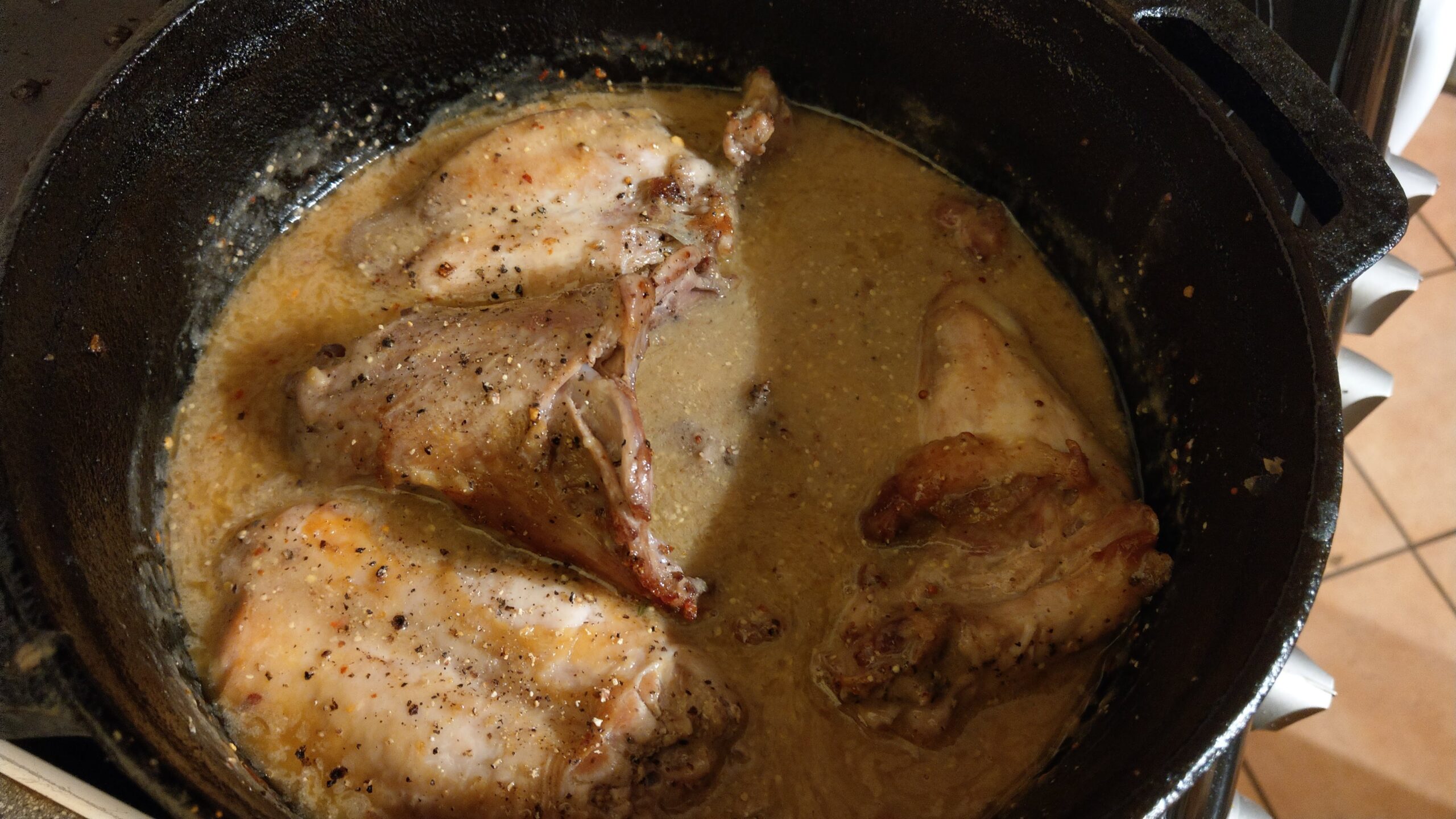
On the stovetop, bring the sauce back to a low boil. Add the thyme sprig and the bay leaf to the pot. (You may like to stick it into the joint that was the ribcage: it’ll be easier to find and remove later. Do make sure you get it out of there when the cooking’s done, as the spine of a bay leaf, even after long cooking, can puncture an unwary diner’s insides.)

Make an internal lid with a piece of foil or baking parchment, and then put the lid on the casserole on top of it. (This helps keep the moisture in during this part of the cooking.)
Put the lidded casserole into the preheated oven and leave it there for 1.5 hours.
At this point the meat should just about be falling off the bones. (Give it another half hour if this isn’t the case. The rabbit should be very, very tender.) Remove the casserole from the oven and put it on the stovetop again.
Take the pieces of rabbit out with a slotted spoon and set them aside on a platter, somewhere where they can stay warm.
Remove the thyme sprigs and bay leaf from the casserole, and stir in the cream. Allow this enriched sauce to simmer gently for five minutes or so. Don’t let it boil (as this may make the cream curdle)….You can also do this in a separate pan, as we did.
Add the rabbit back to the casserole, turn all the pieces to coat them, and lid the casserole again until serving time.When ready to serve, season to taste.
As a garnish (or a side dish), thinly slice some leaves of Savoy cabbage and parboil them very quickly in water that’s had a half teaspoon of baking soda added to it. Boil them for no more than a minute and a half or two minutes.
Then get them out of the hot water and submerge them immediately in very cold or ice water to stop the cooking. When this has been done, season them lightly with salt and pepper and arrange them on your diners’ individual plates: then arrange the rabbit pieces on them, and serve.
And enjoy!
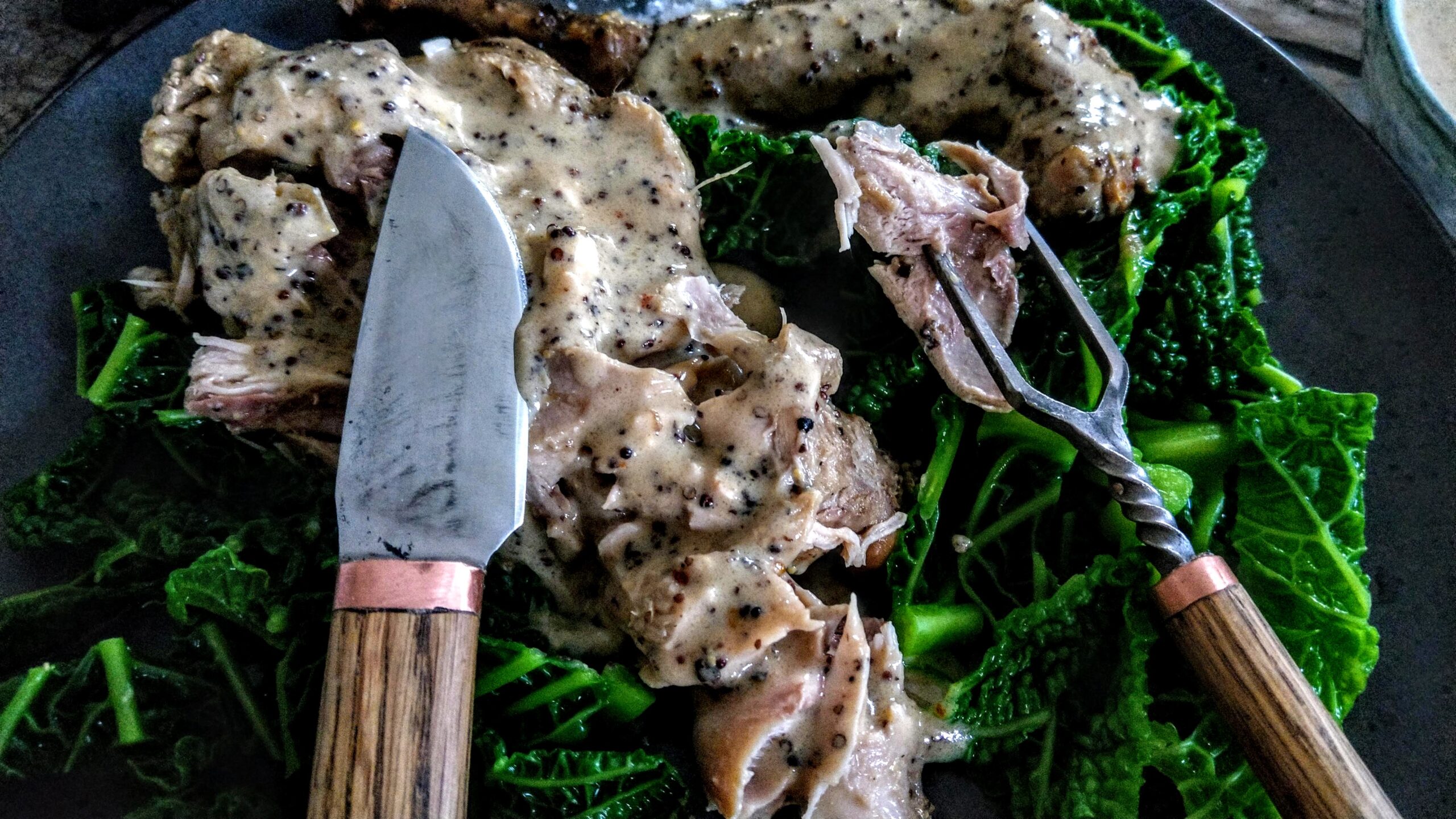
Meat, game



